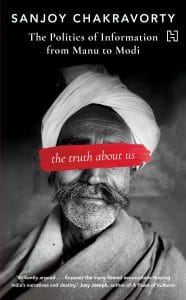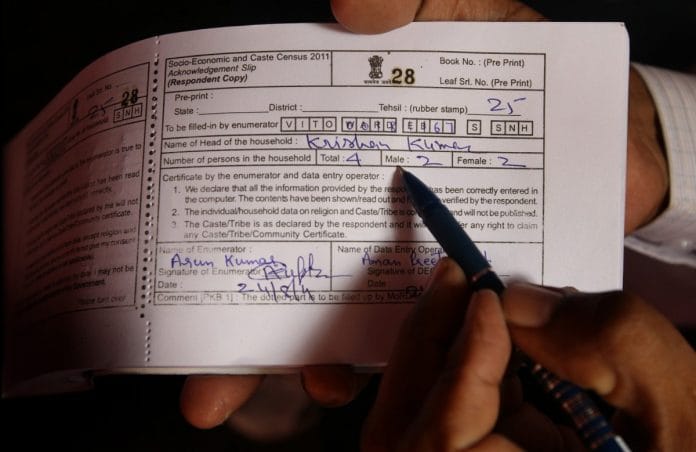I am not arguing that social stratification did not exist in precolonial India. It must have existed (because stratification existed in all settled agricultural societies), but there was no regularity or uniform pattern in the various stratification systems that existed over a large subcontinent demarcated by a medley of jatis, faiths, and languages.
M.N. Srinivas argues that ‘caste mainly exists and functions as a regional system’. Sumit Guha goes further and argues that the system was smaller than regional; it was subregional so that ‘the effective circle of recognition [of caste identity] was the arena constituted by a few dozen villages; the zone of surveillance limited to the immediate area of a village.’ But even Srinivas and Guha, among others, accept that such a thing as caste had widespread existence in India before the conquest by the British. Several other scholars, however, have serious doubts.
How would we know about the condition of caste in India in the precolonial period – what forms it took and how widespread it was? From the surviving written record, of course. We are left with nothing but ‘text’ to understand the past.
Also read: Are Dalit women less or more mobile than upper caste women in India? Jatis hold the answer
What was not written down then and is still available to us to read might as well have not existed. This creates some problems. Perhaps the most important of these is one we have discussed at length earlier – that the written record was largely in Sanskrit (at least the record that the British chose to recognize and canonize) and it propounded the views and ideology of the creators and interpreters of that particular record, the Brahmans. The prime, but not only, example is the Manusmriti and its varna fantasy of Indian society.
These Sanskrit texts were among the first translated by the colonial authorities, and they created, as they were meant to, an image of a society hierarchically organized by caste. This first impression has turned out to be a lasting one.
But it would be a logical error of considerable magnitude to categorize a society based on the caste theory of Brahmanvadi texts and then turn around and claim that the society was categorized by caste. It is a perfect example of a self-fulfilling prophecy: ‘…a false definition of the situation evoking a new behavior which makes the original false conception come true. This specious validity of the self-fulfilling prophecy perpetuates a reign of error.’
If we turn our attention to the precolonial written record that is not in Sanskrit and has been studied by professional historians and philologists, it appears to be largely without any or much mention of caste. Scholars like G.S. Ghurye, Susan Bayly, Richard Eaton, David Shulman and Cynthia Talbot, all experts on precolonial India, have found little mention of varna or jati in the non-Sanskrit texts created in different courts in North and South India, nor in the several traveller and visitor accounts.
Instead, there are numerous instances of ‘slaves’ and ‘Shudras’ and ‘Vaishyas’ who became kings; merchants and soldiers and nomads who were caste-less; large numbers of farmers who were also soldiers; and Brahmans who were farmers, soldiers, traders, or even kings (therefore, following the occupational theory of caste, they were Kshatriyas and Vaishyas too). One’s caste could be changed as easily as moving from one village to another. And such instances were not exceptions, they happened frequently.
These and other scholars also find little textual evidence of systematic and widespread caste oppression or mass conversion to Islam as a result of this oppression. This widely held belief about the mass conversion of ‘low-caste’ groups to Islam is probably an easy and convenient myth. It is a story that seems plausible based on another widely held belief that the caste system in medieval India was so oppressive that groups at the bottom were always looking for ‘justice’ and ‘liberation’. No matter that this narrative flies in the face of another widely held belief about the cruelty and oppression of Muslim kings and the forceful conversions made by them by the power of the sword. If both narratives were true, for the outcastes it must have been a choice between the frying pan and the fire – horrible Brahmans versus terrible Muslims.
Also read: Inter-caste marriages are good for health of Indians. That’s what DNA testing tells us
The fact is that the most widespread conversions took place not in the Hindi heartland, where Muslims ruled, but at the margins of Muslim authority like eastern Bengal, especially among what later came to be called ‘tribal’ communities. Also, conversions to (or acceptance of) Islam took place on a much larger scale in certain societies – like present-day Malaysia and Indonesia – where caste was not a factor. The historian Richard Eaton elegantly dismisses both the ‘sword theory’ and the caste ‘liberation theory’. He questions the very use of the ‘Protestant terminology’ of ‘conversion’ to understand the social and agrarian changes that were taking place in medieval India. Indeed, how could a people without a formal religion – who were quite unaware that in the future they would retroactively be branded ‘Hindu’ – ‘convert’ to another religion! The whole argument is ridiculous. But people believe the narrative that fits their ideology.
We do need, however, to consider one more widely held belief: about the spontaneous growth of the so-called Bhakti movement supposedly in opposition to the caste system. It was not a ‘movement’ in the sense that its followers, separated by hundreds of miles and years, were especially aware of each other or shared a common ideology – other than the one created post hoc by contemporary scholars who have labelled it a ‘movement’. But did these separate flowerings of devotion cults and their poets/philosophers – from Andal in eighth-century Tamil Nadu, Basava in twelfth-century Karnataka, to Kabir in fifteenth-century Uttar Pradesh, and Chaitanya in sixteenth- century eastern India – signal something about caste oppression in these times and places? The interpretation that it did is widely circulated.
See, for example, how people understand Kabir’s famous doha ‘Jaat na poochho sadhu ki’ (I would translate this as: ‘Ask not what community the holy man belongs to’; most others translate this as: ‘Ask not for the caste of the priest’; while Google translates ‘jati’ to ‘race’, and ‘sadhu’ to ‘sage’.)
Surely, a strong alternative interpretation of the ‘egalitarian’ message of the Bhakti leaders is as an anti-priest or anti-cleric position (against both Brahmans and mullahs) rather than as an anti-caste ideology. As Ambedkar wrote: ‘The saints [Ambedkar specifically mentions Jnyandeo and Eknath] have never, according to my study, carried out a campaign against caste and untouchability. They were not concerned with the struggle between men. They were concerned with the relationship between man and god.’
The question I am raising here is: Why would the reformers have focused on removing intermediaries (like Brahmans and mullahs) but not have campaigned against caste oppression? Was it because they were more interested in higher spiritual issues (as Dr Ambedkar suggests) or because caste oppression was not as deep or widespread as many imagine it was? Each of us may believe that we know the answer, but I am not sure that we do.
Consider also the findings in Nicholas Dirks’s Castes of Mind, which is a detailed and persuasive study of what he calls ‘the career of caste’ in India. Dirks examined ‘the vast collection of local texts, traditions, and histories’ of Colin McKenzie, a colonial cartographer (someone who would be called an ethnographer today), who worked in southern India in 1784– 1821, and ‘encountered very little concerning “caste”’. Dirks does ‘not mean to imply that [caste] was simply invented by the too clever British… But…that it was under the British that “caste” became a single term capable of expressing, organizing, and above all “systematizing” India’s diverse forms of social identity, community, and organization.’ In other words, ‘caste’ was a convenient simplification by the British. Their choices and policies made it real and pan-Indian.
Also read: Indian history tells us that to move beyond Hindu nationalism, we must move beyond identity
The ‘ethnographic state’ created by the British erected a knowledge structure for ruling and control in which Hinduism was the foundation and caste the reinforced steel that held it together. This idea – that the caste system held Hindu society together, that without it the society would have fallen apart and taken with it the British Empire too – was widely held, as was the completely opposite belief that the caste system created such fissures that Indian society could never come together as a whole to throw off the imperial power. According to both interpretations, to intervene in caste would lead to the ‘loss of India’, but for opposite reasons.
Whether caste was the steel in the mortar or the crack in the foundation, the British Indian government found multiple justifications for not intervening in what they considered to be an ancient social system of bias and injustice. Their ‘civilizing mission’ had its limits. By the time they intervened – two decades before independence – it was, if anything, a tactic to delay the end of the empire. More on this soon.
 Excerpted with permission of Hachette India from The Truth About Us: The Politics of Information from Manu to Modi by Sanjoy Chakravorty
Excerpted with permission of Hachette India from The Truth About Us: The Politics of Information from Manu to Modi by Sanjoy Chakravorty
Hardback Rs. 499







You are absolutely correct Sanjay! How on earth does a socalled caste system give only responsibilities but no privileges to its highest ranking members i.e the Brahmins? Brahmins were kept out of wealth accumulation, land ownership and reservations have kept many poor unto this day. They had no armies, no treasury and just duties like the priestly ones, teaching, science and scholarship(with no pay) besides which they had to do Biksha to get their sustenance. Its through their very spirit- one that got us our independence(70% of freedom fighters were Brahmins), that many have climbed out of the rut that the British, their chamchas in India and the current reservation system has put them in. Any authority a Brahmin derives is not through his/her lineage as Rishi putra/putris but through their knowledge of the Vedas. If the westerners had such a religion/social system, they would cherish it but since it belongs to another, they had to destroy it- ergo the British empire’s villification of Brahmanism/Hinduism. Many Indians and westerners have made their careers out of the socalled Indian caste system, so I doubt they would recognise that Brahmins in India are amongst the most oppressed minorities in the world today and that this was’nt really a caste system. Even the word itself is derived from Portugese/Latin.
Thank you for your enlightend view.
Yes Britishers invented Hinduism too in India. Remove Hinduism Remove Castism and then we will leave Reservation.
Peace